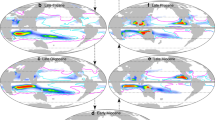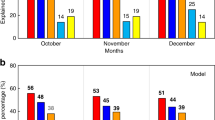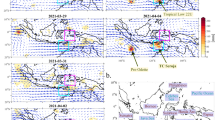Abstract
Tropical cyclone (TC) activity in the northern Mozambique Channel (nMC) during the satellite era is studied, culminating with the anomalous 2019 season. We identify 21 westward-moving TCs since 1979 and analyze regional to local conditions as they move over the nMC. As easterly flow is needed to steer these TC into the channel and over land, we look for scenarios under which this flow is established along with thermodynamic conditions necessary to support TCs. At seasonal scales there is a dichotomy between westward steering flow and reduced thermodynamic energy during Pacific La Niña and cool-phase Indian Ocean Dipole (–IOD). Equatorial convective systems (Madden Julian Oscillation, MJO) entering the west Indian Ocean can trigger TC formation and subtropical ridging, more effectively at the end of austral summer. Conditions in early 2019 favoured westward flow over Madagascar. The onset of warm phase + IOD was evident in the Walker circulation and downwelling ocean Rossby wave that warmed SST to 31 °C north of Madagascar. High-amplitude MJO triggered the genesis of TCs Idai (March) and Kenneth (April) and both TCs transited the Mozambique Channel causing unprecedented floods. TC Kenneth intensified rapidly, and satellite rainfall and upper level ozone indicated the presence of a southern spiral cloud band that shielded the TC from the sub-tropical jet over Madagascar. Numerical model forecasts of track and intensity are evaluated.








Similar content being viewed by others
Data Availability
A data spreadsheet is available on request, including much of the analysis here, url links to websites for data and macro subroutines employed in statistical processing and analysis.
References
Ash KD, Matyas CJ (2012) The influences of ENSO and the Subtropical Indian Ocean dipole on tropical cyclone trajectories in the South Indian Ocean. Intl J Climatol 32:41–56
Barimalala R, Desbiolles F, Blamey RC, Reason C (2018) Madagascar influence on the South Indian Ocean convergence zone, the Mozambique channel trough and Southern African rainfall. Geophys Res Letters 45:11380–11389
Behringer DW (2007) The global ocean data assimilation system (GODAS) at NCEP. Proc 11th Symp on Integrated Observing and Assimilation Systems, San Antonio TX, Amer Meteor Soc:3.3
Bessafi M, Wheeler MC (2006) Modulation of south Indian Ocean tropical cyclones by the Madden-Julian Oscillation and convectively coupled equatorial waves. Mon Weather Rev 134:638–656
Burns JM, Subrahmanyam B, Nyadjro ES, Murty VSN (2016) Tropical cyclone activity over the southwest tropical Indian Ocean. J Geophys Res Oceans 121:6389–6402
Burpee RW (1972) The origin and structure of easterly waves in the lower troposphere in North Africa. J Atmos Sci 29:77–90
Carton JA, Chepurin GA, Chen L (2018) SODA3: A new ocean climate reanalysis. J Climate 31:6967–6983
Cattiaux J, Chauvin F, Bousquet O, Malardel S, Tsai C (2020) Projected changes in the southern Indian Ocean cyclone activity assessed from high-resolution experiments and CMIP5 Models. J Climate 33:4975–4991
Chang-Seng D, Jury MR (2010a) Tropical cyclones in the SW Indian Ocean. Part 1: inter-annual variability and statistical prediction. Meteorol Atmos Phys 106:149–162
Chang-Seng D, Jury MR (2010b) Tropical cyclones in the SW Indian Ocean. Part 2: structure and impacts at the event scale. Meteorol Atmos Phys 106:163–178
Chikoore H, Vermeulen JH, Jury MR (2015) Tropical cyclones in the Mozambique channel: January–March 2012. Nat Hazards. https://doi.org/10.1007/s11069-015-1691-0
Cretat J, Terray P, Masson S, Sooraj KP (2018) Intrinsic precursors and timescale of the tropical Indian Ocean Dipole: insights from partially decoupled numerical experiment. Climate Dyn 51:1311–1332
Doyle JD, Hodur RM, Chen S, ** Y, Moskaitis JR, Wang S, Hendricks EA, ** H, Smith TA (2014) Tropical cyclone prediction using COAMPS-TC. Oceanography 27:104–115
Dyson LL, vanHeerden J (2001) The heavy rainfall and floods over the northeastern interior of South Africa during February 2000. S Afr J Science 97:80–86
Emanuel KA, Nolan DS (2004) Tropical cyclone activity and global climate. 26th Conf Hurr Tropical Meteorol, Miami FL, Amer Meteor Soc:240–241
Fitchett JM, Grab SW (2014) A 66-year tropical cyclone record for south-east Africa, temporal trends in a global context. Intl J Climatol:doi. https://doi.org/10.1002/joc.3932
Hersbach H (2020) The ERA5 global reanalysis. Quart J Roy Meteor Soc 146:1999–2049
Ho CH, Kim JH, Jeong JH, Kim HS, Chen DL (2006) Variation of tropical cyclone activity in the South Indian Ocean: El Nino-Southern oscillation and Madden-Julian oscillation effects. J Geophys Res Atmos. https://doi.org/10.1029/2006jd007289
Hou AY, Kakar RK, Neeck S, Azarbarzin AA, Kummerow CD, Kojima M, Oki R, Nakamura K, Iguchi T (2014) The global precipitation measurement mission. Bull Amer Meteor Soc 95:701–722
Huffman GJ, Adler RF, Bolvin DT, Gu G, Nelkin EJ, Bowman KP, Hong Y, Stocker EF, Wolff DB (2007) The TRMM multi-satellite precipitation analysis (TMPA): quasi-global, multiyear, combined-sensor precipitation estimates at fine scales. J Hydrometeor 8:38–55
Hurlburt HE (2009) High resolution global and basin-scale ocean analyses and forecasts. Oceanography 22:110–127
Izumo T, Vialard J, Lengaigne M, deBoyer-Montégut C, Behera SK, Luo JJ, Cravatte S, Masson S, Yamagata T (2010) Influence of the state of the Indian Ocean dipole on following year’s El Niño. Nature Geosci 3:168–172
Jenkins GS, Robjhon ML, Reyes A, Valentine A, Nieves L (2015) Elevated middle and upper troposphere ozone observed downstream of Atlantic tropical cyclones. Atmos Environ 118:70–86
Joyce RJ, Janowiak JE, Arkin PA, **e PP (2004) CMORPH: a method that produces global precipitation estimates from passive microwave and infrared data at high spatial and temporal resolution. J Hydrometeor 5:487–503
Jury MR (1993) A preliminary study of climatological associations and characteristics of tropical cyclones in the SW Indian Ocean. Meteorol Atmos Phys 51:101–115
Jury MR (2013) Variability in the tropical southwest Indian Ocean and influence on Southern Africa climate. Intl J Marine Sci 3:46–64
Jury MR (2016) Summer climate of Madagascar and monsoon pulsing of its vortex. Meteorol Atmos Physics 128:117–129
Jury MR (2018a) South Indian Ocean Rossby waves. Atmos Ocean 56:322–331
Jury MR (2018b) Modulation of currents near Durban. Reg Stud Marine Sci 18:208–218
Jury MR, Huang B (2004) The Rossby wave as a key mechanism of Indian Ocean climate variability. Deep Sea Res 51:2123–2136
Jury MR, Pathack B, Parker B (1998) Climatic determinants and statistical prediction of tropical cyclone days in the southwest Indian Ocean. J Climate 12:1738–1746
Kanamitsu M, Ebisuzaki W, Woollen J, Yang SK, Hnilo JJ, Fiorino M, Potter GL (2002) NCEP-DOE AMIP-2 Reanalysis. Bull Amer Meteor Soc 83:1631–1643
Kiladis GN, Dias J, Straub KH, Wheeler MC, Tulich SN, Kikuchi K, Weickmann KM, Ventrice MJ (2014) A comparison of OLR and circulation-based indices for tracking the MJO. Mon Wea Rev 142:1697–1715
Leroux M, Meister J, Mekies D, Dorla A, Caroff P (2018) A climatology of southwest Indian Ocean tropical systems: their number, tracks, impacts, sizes, empirical maximum potential intensity, and intensity changes. J Appl Meteor Climatol 57:1021–1041
Lin J (2009) Ocean-atmosphere interaction in the lifecycle of ENSO: The coupled wave oscillator. Chin Ann Math Ser B 30:715–726
Lin Z (2019) The south Atlantic-south Indian Ocean pattern: a zonally oriented teleconnection along the southern hemisphere westerly jet in austral summer. Atmosphere. https://doi.org/10.3390/atmos10050259
Luo J-J, Zhang R, Behera SK, Masumoto Y, ** F-F, Lukas R, Yamagata T (2010) Interaction between El Niño and extreme Indian Ocean dipole. J Climate 23:726–742
Madden RA, Julian PR (1994) Observations of the 40–50 day tropical oscillation – A review. Mon Wea Rev 122:814–837
Malan N, Reason CJC, Loveday B (2013) Variability in tropical cyclone heat potential over the southwest Indian Ocean. J Geophys Res Oceans 118:6734–6746
Malherbe J, Engelbrecht FA, Landman WA, Engelbrecht CJ (2011) Tropical systems from the southwest Indian Ocean making landfall over the Limpopo River Basin, southern Africa: a historical perspective. Intl J Climatol:doi. https://doi.org/10.1002/joc.2320
Malherbe J, Engelbrecht FA, Landman WA (2012) Projected changes in tropical cyclone climatology and landfall in the southwest Indian Ocean under enhanced anthropogenic forcing. Clim Dyn: https://doi.org/10.1007/s00382-012-1635-2
Malherbe J, Landman WA, Engelbrecht FA (2013) The decadal-scale rainfall cycle, Southern Annular Mode and tropical cyclones over the Limpopo River Basin, southern Africa. Clim Dyn 42:3121–3138
Masters J (2019) Africa's hurricane Katrina: tropical cyclone Idai causes an extreme catastrophe. Weather Underground. <www.wunderground.com/cat6/Africas-Hurricane-Katrina-Tropical-Cyclone-Idai-Causes-Extreme-Catastrophe>
Matyas CJ (2015) Tropical cyclone formation and motion in the Mozambique channel. Intl J Climatol 35:375–390
Matyas CJ, Silva JA (2011) Extreme weather and economic well-being in rural Mozambique. Nature Hazards: https://doi.org/10.1007/s11069-011-0064-6
Mavume AF, Rydberg L, Rouault M, Lutjeharms JRE (2009) Climatology and landfall of tropical cyclones in the south-west Indian Ocean. W Indian Ocean J Marine Sci 8:15–36
Mawren D, Hermes J, Reason CJC (2020) Exceptional tropical cyclone Kenneth in the far northern Mozambique Channel and ocean eddy influences. Geophys Res Lett 47:e2020GL088715
McIntosh PC, Hendon HH (2018) Understanding Rossby wave trains forced by the Indian Ocean dipole. Clim Dyn 50:2783–2798
McNally A, Arsenault K, Kumar S, Shukla S, Peterson P, Wang S, Funk C, Peters-Lidard CD, Verdin JP (2017) A land data assimilation system for sub-Saharan Africa food and water security applications (FLDAS). Scientific Data 4:170012
McPhaden MJ (2009) RAMA: The rsearch Moored Array for African–Asian–Australian Monsoon analysis and prediction. Bull Amer Meteor Soc 90:459–480
Minschwaner K (2015) Signature of a tropical Pacific cyclone in the composition of the upper troposphere over Socorro NM. Geophys Res Lett 42:9530–9537
Molod A, Takacs L, Suarez M, Bacmeister J (2015) Development of the GEOS-5 atmospheric general circulation model: evolution from MERRA to MERRA2. Geosci Model Dev 8:1339–1356
Moore GWK (2013) Impact of the high topography of Madagascar on the structure of the Findlater Jet. Geophys Res Lett 40:2367–2372
Mudenda OS, Mumba ZLS (2004) The unusual storm of January 1996. Proc EUMETSAT meteorological satellite conf, Prague Czech Rep
Poolman E, Terblanche D (1984) Tropical cyclones Domoina and Imboa. SA Weather Bureau Newslett 420:37–45
Reason CJC (2007) Tropical cyclone Dera, the unusual 2000/01 tropical cyclone season in the southwest Indian Ocean and associated rainfall anomalies over southern Africa. Meteor Atmos Phys 97:181–188
Reason CJC, Kiebel A (2004) Tropical cyclone Eline and its unusual penetration and impacts over the southern African mainland. Weather Forecast 19:789–805
ReliefWeb (2019) Document on Cyclone Kenneth <reliefweb.int/report/comoros/comoros-humanitarian-situation-report-no-6-cyclone-kenneth-3-june-2019>
MeteoFrance Reunion (2019) Diagnostic observations of TC Kenneth <www.meteofrance.re/cyclone/saisons-passees/2018-2019/dirre/KENNETH>
Rienecker MM (2011) MERRA: NASA’s Modern-Era Retrospective Analysis for Research and Applications. J Climate 24:3624–3648
Saha S (2010) The NCEP Climate Forecast System Reanalysis. Bull Amer Meteor Soc 91:1015–1057
Saji NH, Goswami BN, Vinayachandran PN, Yamagata T (1999) A dipole mode in the tropical Indian Ocean. Nature 401:360–363
Schott FA, **e S-P, McCreary JP (2009) Indian Ocean circulation and climate variability. Rev Geophys. https://doi.org/10.1029/2007RG000245
Tolman HL, Balasubramaniyan B, Burroughs LD, Chalikov DV, Chao YY, Chen HS, Gerald VM (2002) Development and implementation of wind generated ocean surface wave models at NCEP. Weather Forecast 17:311–333
Vermeulen JH (1995) Tropical cyclones in the southwest Indian Ocean: track prediction and verification 1991–1992. Meteorol Appl 2:217–220
Vitart F, Anderson D, Stockdale T (2003) Seasonal forecasting of tropical cyclone landfall over Mozambique. J Climate 16:3932–3945
Wang B, Elsberry RL, Wang Y, Wu L (1998) Dynamics in tropical cyclone motion: a review. Chin J Atmos Sci 22:416–434
Webster PJ, Moore AM, Loschingg JP, Leben RR (1999) Coupled ocean-atmosphere dynamics in the Indian Ocean during 1997–98. Nature 401:356–360
Wheeler MC, Hendon HH (2004) An all-season real-time multivariate MJO index: development of an index for monitoring and prediction. Mon Wea Rev 132:1917–1932
WMO (2019) document on TC Kenneth <public.wmo.int/en/media/news/another-unprecedented-tropical-cyclone-and-flooding-hits-mozambique>
**e SP, Annamalai H, Schott FA, McCreary JP (2001) Structure and mechanism of south Indian Ocean climate variability. J Climate 15:864–878
Yeshanew A, Jury MR (2007) North African climate variability, part 1: tropical thermocline coupling. Theor Appl Climatol,. https://doi.org/10.1007/s00704-006-0242-8
Zou X, Wu Y (2005) On the relationship between Total Ozone Map** Spectrometer ozone and hurricanes. J Geophys Res. https://doi.org/10.1029/2004JD005019
Acknowledgements
Satellite, reanalysis and vortex-scale model data were obtained from Univ Hawaii APDRC, KNMI Climate Explorer, IRI Climate Library, NOAA Coastwatch, Navy Coamps-TC. The first author acknowledges on-going support from the SA Dept of Education.
Author information
Authors and Affiliations
Corresponding author
Additional information
Responsible Editor: Clemens Simmer.
Publisher's Note
Springer Nature remains neutral with regard to jurisdictional claims in published maps and institutional affiliations.
Appendix
Appendix
See below Fig. 9.
a Representing the IOD with 1–100 m sub-surface sea temperatures south of the equator: (i) Empirical orthogonal function mode-1 loading pattern and (ii) filtered time score, (iii) mean annual cycle segregated into warm and cool phase, and (iv) IOD vs Nino3.4 scatterplot and regression. Red circle indicates 2019 IOD was decoupled from the Pacific. b Global MJO RMM diagram Apr–Jun 2019 (Wheeler and Hendon 2004); black dot (below left) denotes the genesis of TC Kenneth in the nMC
Rights and permissions
About this article
Cite this article
Jury, M.R., Matyas, C.J. Tropical cyclones in the northern Mozambique Channel: composite intra-seasonal forcing and 2019 event. Meteorol Atmos Phys 134, 70 (2022). https://doi.org/10.1007/s00703-022-00911-8
Received:
Accepted:
Published:
DOI: https://doi.org/10.1007/s00703-022-00911-8





